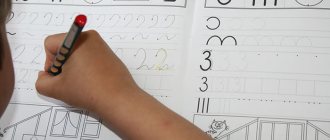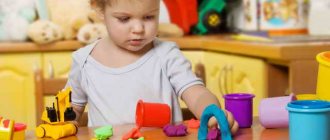Mastering subtraction by preschool children is an important stage in their maturation, development of intelligence and personal qualities. You can start practicing from the age of 2, gradually making the tasks more difficult. First, they study quantitative and ordinal counting, and then move on to more complex operations with numbers.
When working with a preschooler, it is important not to force him to take lessons if he does not have the desire or mood, otherwise it will provoke aversion to learning and mathematics. Therefore, before teaching your child addition and subtraction, make sure he has had enough sleep and is in a good mood. Exercise in a playful way, using toys, improvised things, bright books and notebooks.
When should you teach your child to count?
No one can name the exact dates, but it has been scientifically proven that at 2-3 years a child has the strongest need for new knowledge and obtaining information. Now the baby is ready to learn everything, he absorbs knowledge like a sponge, reaches out to the unknown and generally provides an ideal soil for cultivating certain abilities.
That is why it is better to start introducing numbers to your child between the ages of two and three. However, you can do this earlier. Already at the age of one, children are able to understand that one and two are different things, although they are not yet able to fully understand the quantitative states of objects.
How to teach counting to 10?
Counting to 10 is the main task that a parent of a small child needs to set. But it can be difficult for a baby to master 10 numbers at once, so first teach your baby to count to 5.
To do this, you can resort to the following methods, which are easy to implement at home.
- There are five fingers on the hand - starting from this, introduce the little one to the “names” of the numbers.
- Show cards with objects depicted on them (from one to five) - remember, it is better not to show the image of the numbers themselves to the baby for now.
- Educational cartoons and programs - they can be found on the Internet.
- Abacus and other educational toys.
- Poems and nursery rhymes.
- Counting in everyday life.
It’s very good if you introduce your baby to household chores while teaching him to count. For example, you can instruct your little one to wash five cups. At the same time, ask your child to count: one cup, two cups. Or before going to the store, ask your child to remember five items from the grocery list. Your child should remind you of what you need to buy. At the same time, you can bend your fingers so as not to lose count. This will allow both to teach the child to count in his head and to take care of the development of his memory.
Useful: We teach a child to dress without whims and unnecessary stress
Exercises with cards will be useful. Such manuals are sold in all bookstores and online stores for children. First, show the cards sequentially, then alternate - let the child answer how many objects are shown on the card (remember that we are not teaching writing numbers yet!)
But try not to bore your child with your “math.” Do everything unobtrusively and easily, in a playful way, so that your child does not prematurely feel like a student in a school class.
This activity is similar to when you want to teach a child to read syllables and gradually introduce him to letters and sounds. Take your time and make sure your child has thoroughly mastered the information before moving on to the next stage of learning.
Zaitsev's technique
This teaching method will help teach the student logical reasoning, analysis and generalization of the information received. Most often, this technique is used for students in grades 1 and 2.
- Children are given special cards with numbers from 0 to 99 and tables that show the composition of the number. The required number of cells is shaded.
- Children become familiar with the numbers in the top ten, determining their composition.
- The next stage: performing arithmetic operations with numbers.
- It is recommended to write down examples.
How to teach a child to write numbers?
After the first 10 numbers have been learned, you can show your child how to write them. It’s better not to overload your baby’s memory and study one written number a day.
Dedicate your whole day to digital:
- write it on a piece of paper and hang it in a visible place;
- Together with your child, fashion a number out of plasticine;
- watch a program that talks about this figure;
- Give examples using a calendar. For example, “On the 2nd we will go to grandma.”
Such a simple and everyday object as a watch will help your child write numbers. The child has probably seen it many times, so the numbers on the dial will not be new to him.
How to teach counting to 20?
The next stage of a child's mathematical education at home will be counting to 20. You should start classes only when the baby has already mastered the numbers from 1 to 9 and the number 10 well.
- Explain that each subsequent number (beyond 10) will consist of two digits. In other words, each number is divided into tens and ones. The first digit is tens, the second is units.
- Use two boxes. Place ten objects (balls, cubes, etc.) in one and one (2, 3, 4) in the other; this visual example will help the baby understand what’s what.
- Say that all the numbers in the ones position come one after another, that is, after 11 comes 12, then 13, 14, etc.
- When your child understands the essence of counting to 20, you can give him a small task. For example, ask your child to put 16 sweets (candies, balls) into an empty box. In this case, the baby must count out loud.
Useful: Teaching your baby to roll over on his own
Learning to count with a column
You should start learning to count in columns by making sure that the little person has a good understanding of counting up to 100 and understands tens. If everything is fine, explain how single-digit and multi-digit numbers are formed and show how they are written. After this, convey to the child’s consciousness that operations with numbers are carried out bitwise, i.e. They work separately with units and tens when counting in columns.
If you add numbers that add up to more than ten, your child may initially have misunderstandings. For example, you need to add “14” and “18”. So, adding “4” and “8” and getting “12”, you need to write down the second digit, and keep the first one in mind, so that you can then add it with the sum of the first column of numbers. Those. “1” + “1” “2” + “1” (the unit that was in the mind) “3”. As a result, in the first column we get “3”, and in the second “2”, which means “32”. If suddenly your child has difficulty keeping one number in his mind, make the task easier for him by writing it above the first column. As you master the method, it is better to eliminate auxiliary techniques.
In fact, a child should not have any problems mastering the ability to count with a column. But you always need to be patient, and if necessary, explain the same thing several times as clearly as possible. And here it would be appropriate to mention the three main rules for teaching children to count.
6
How to teach counting to 100?
By the age of 4-5, when the baby is already counting from 1 to 20, you can introduce him to numbers up to 100. This requires some patience and time; learning to count is a rather long and labor-intensive process.
So, how can you teach your child to quickly count to one hundred?
- First of all, tell us that there are 9 tens in the number series up to 100. Name the numbers - 10, 20, 30, 40, 50, 60, 70, 80, 90. But make a reservation that between these numbers there are still units, that is, these the numbers don't go one after another.
- After this short overview lesson, encourage your child to learn 10 new numbers per day. Start with the third ten (21, 22, 23...). Before going to bed, ask your baby to tell you what he has learned. At the same time, you can repeat the material covered by counting any objects.
- When your child has learned several dozen numbers, play a game with him: show him a number line with a missing number in the middle. The kid must find and insert the lost element.
- Praise your child for correct answers and rejoice at his success. Motivate your child to learn.
Preparing for training
Before moving on to teaching, adults must first of all explain to the child what a number is and what a figure is. Young children do not see the difference in these two units. In order to demonstrate the use of mental counting, it is worth using educational material already familiar to the child, for example: soft toys, dolls, cars, cubes, balls.
Training should be carried out in the form of an entertaining and dynamic game in order to arouse the student’s interest. If the child is tired, it is better to end the lesson. When children perceive learning as an exciting game, it subsequently becomes one of their favorite activities.
How to teach addition and subtraction?
Basic operations such as addition and subtraction will be useful to your child even before school. The ability to count objects in everyday life will give the baby self-confidence and also give impetus to the development of intelligence. But where to start?
First of all, remember - no math lessons! Just a game and an interesting pastime.
- Prepare visual materials: apples, candies, cubes - something that will be interesting for your baby to operate with.
- First, parse a prime number (for example, 3). You can get a total of 3 by adding two candies and one. Ask your child to show how much he understands the explanation.
- Continue adding until your child understands what's what, and only then move on to subtraction.
- Comment on your actions: I will take two candies, there will be one left.
- Place candy (or other items) into piles. For example, two, three, four items. Ask your child to combine any two piles and name the number of items in the new pile without counting them.
Helpful: Is your newborn developing properly?
Use special books and notebooks that provide easy examples for learning addition and subtraction.
Paper handling
All children love to draw, and they all love the positive reaction of their parents to this. After you have managed to teach your child theoretical calculation, you need to move on to practical work. To make it easier to explain to your child why each number is written this way, you should remember one simple rule - each number has its own number of angles. Those. The one has only 1 angle, while the eight has 8.
Such a clear example can easily orient a child, but in the process you need to be prepared to “invent” new numbers, which in no case should be rejected. Let them be - then they will disappear on their own.
To begin with, it is advisable to purchase any children's educational notebooks, of which there are more and more every year. Their main convenience is the presence of ready-made drawings, thanks to which the child will see what exactly he is adding or subtracting. You can trust yourself to record the results yourself, although the first attempts will be very clumsy. Over time, in these same notebooks, apples and cones will be replaced by numbers, which will be a new step in development.
- Copybooks “Learning to write numbers. Workbook for children 5-6 years old" from Elena Bortnikova
- Copybooks by L. Mavrina “Friend. Recipes for preschoolers. Learning to write numbers"
- And original reusable cards “I’m learning to write numbers” from Bourget, Brust, Courvoisier
Tips and tricks
- Repeat! But remember that children cannot stand being examined, so include new knowledge in any test, as well as a game moment, so that the child does not feel like he is in an exam.
- Try to convey to your child the essence of counting at home before he or she goes to school. It is not advisable for the baby to memorize the material; it is better if he understands the very mechanism of composing numbers from numbers.
- Game "Name Your Neighbor". Invite your child to name the numbers that are on both sides, for example, the number 5.
- Include more visual teaching material in your lessons. These could be toys, children's abacus, or books with simple tasks (count kittens, etc.)
- To help your baby understand the order of numbers clearly, show him a ruler. Use it as a cheat sheet if your child forgets the sequence of numbers.
What parents need to understand
Some parents simply don't know how to start doing this.
Now there are many specialized books on how to teach a child to count. Psychologists assure that if you decide to start training , you should follow these recommendations:
- be patient - not every child is able to learn counting quickly; some need more time to learn new things. Repeat the material you have covered more often if you see that it is difficult for your child to remember;
- show delicacy - do not scold the child if he cannot answer one or another question posed. Such methods will not give results, but can only negatively affect the psyche;
- lessons should be interesting, especially when it comes to preschoolers - if schoolchildren already understand the need for learning, then young children should perceive learning as a game, choose easy and interesting examples;
- systematize the training - the teaching time for children should not exceed 15 minutes, each lesson should always last the same amount of time. It is better to study little by little, but often, so that the child learns to count;
- do not forget to repeat what you have covered, but without overload. Kids should not get tired from activities.










